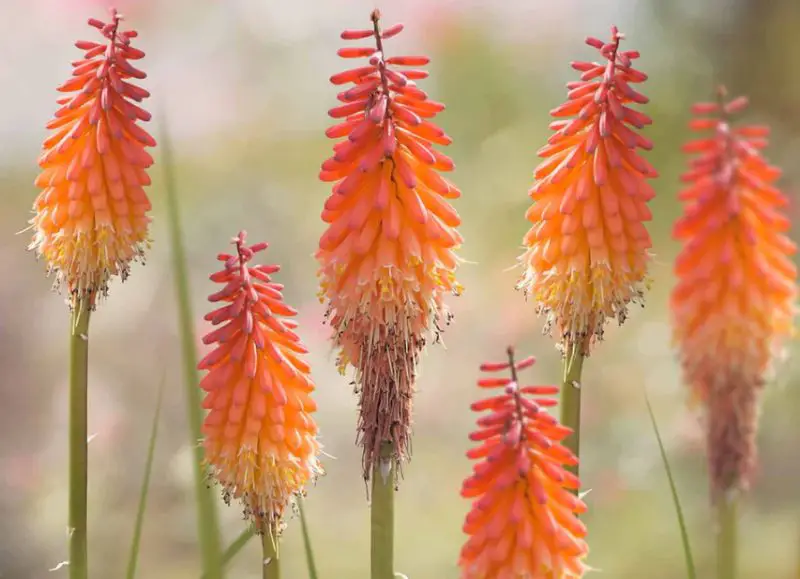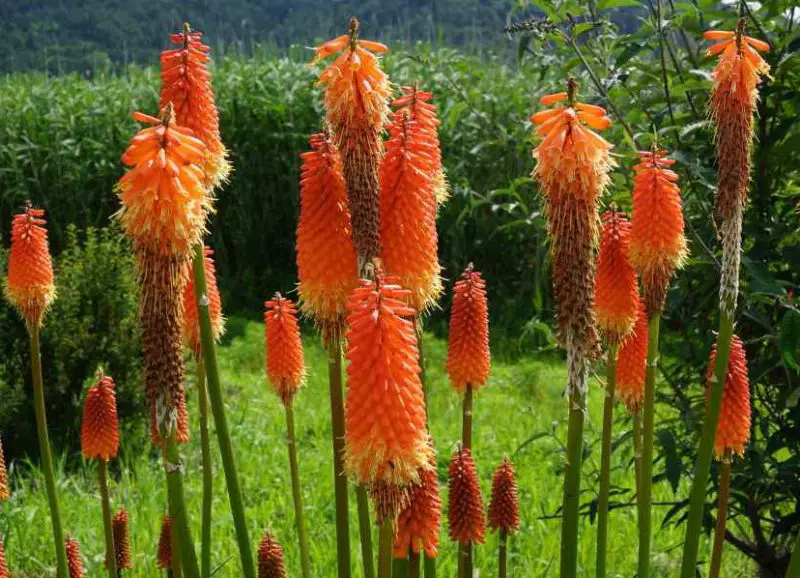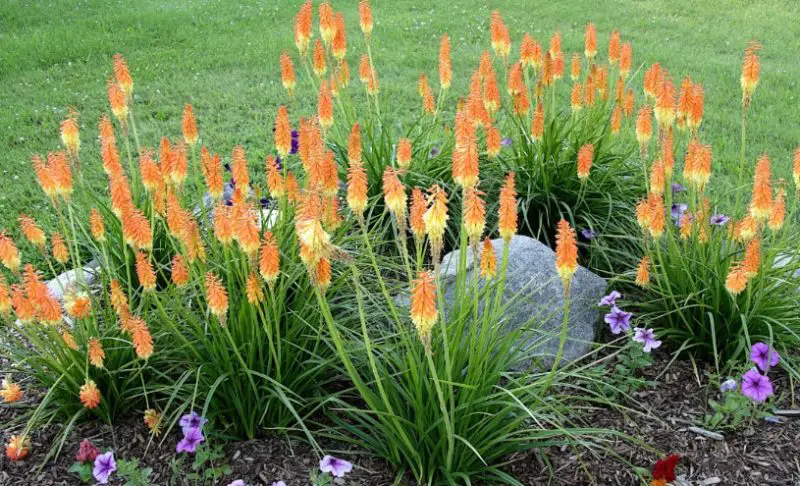The Red Hot Poker plant, also known as Kniphofia, is a beautiful addition to any garden with its tall, striking flower stems in vibrant shades of red, orange and yellow.
In this detailed care guide, we’ll explore everything you need to know to grow and nurture these beautiful perennials. From optimal growing conditions to pruning techniques and propagation methods, discover how to ensure your Red Hot Poker plant thrives and blooms profusely throughout the seasons.
About Red Hot Poker Plant

Red hot poker plant (Kniphofia), also known as torch lily or African flame flower, is a striking herbaceous perennial belonging to the Kniphofia genus within the Asphodelaceae family. Originating from South Africa, this plant boasts vibrant blooms that resemble torches, hence its various common names including torch flower and Devil’s poker.
In terms of its botanical attributes, the red hot poker typically reaches a mature height of 3 to 4 feet tall and spreads 2 to 3 feet wide, making it an ideal choice for adding vertical interest to gardens. Its preference for full sun exposure and well-drained soil makes it suitable for a variety of garden settings. Additionally, it thrives in neutral soil pH levels.
One of the most striking features of the red hot poker plant is its stunning bloom display. Spring and summer bring forth tall spikes adorned with tubular flowers in shades of red, yellow, and orange, creating a fiery spectacle in the garden landscape. These vibrant hues not only attract pollinators but also add a pop of color to any garden bed or border.
Hardy in USDA hardiness zones 5 to 9, the red hot poker plant is relatively low-maintenance once established, requiring minimal care to thrive. Regular watering during dry spells and occasional fertilization can help promote healthy growth and abundant blooms.
Overall, with its bold colors, unique form, and adaptability to a range of growing conditions, the red hot poker plant is a standout choice for gardeners looking to add a touch of drama and flair to their outdoor spaces. Whether planted en masse or as a focal point, this charismatic perennial is sure to captivate admirers and enhance the beauty of any landscape.
Red Hot Poker Plant Care

For optimal growth of Red Hot Poker plants, trim their foliage base in spring to a few inches above ground level. These plants thrive in full sun and have modest water needs. Ensure they’re planted in well-draining soil to prevent waterlogging. The simple care steps below will promote healthy growth and vibrant blooms.
Light
To maximize the vibrant blooms of your red hot poker plants, it’s crucial to provide them with ample sunlight. Plant them in full sun for optimal growth and flowering. While they can tolerate some shade, consider providing afternoon shade in regions with particularly hot summers. This adjustment helps prevent stress on the plants and ensures they continue to thrive and produce their striking flowers.
Soil
Red hot poker plants are resilient perennials, but their survival hinges on well-draining soil. Adequate drainage is paramount, as excess moisture, especially in the winter, can spell disaster for these hardy plants. Poor drainage is among the few factors that can lead to their demise. Thus, ensuring the soil’s ability to efficiently drain water is crucial for maintaining the health and vigor of red hot poker plants year-round.
Water
Once established, Kniphofia, commonly known as red hot poker, displays modest water requirements. Initially, after planting, it’s essential to water the plant frequently to help it establish its root system. However, as the plant matures, its water needs diminish. In subsequent seasons, reduce watering frequency, allowing the soil to dry out slightly between waterings. This approach promotes healthy growth while preventing waterlogging, ensuring the longevity and vitality of your red hot poker plant.
Temperature and Humidity
Originating from South Africa, red hot pokers are resilient enough to thrive in climates as cold as zone 5, extending to the warmer temperatures of zone 9, provided they have adequate drainage and mulch. In colder regions, it’s advisable to winterize the plants by covering their crowns with mulch. This protective layer helps insulate the plants from freezing temperatures, ensuring their survival through the winter months and promoting healthy regrowth come spring.
Fertilizer
Red hot poker plants usually thrive in nutrient-rich soil without the need for additional fertilization. However, in cases where the soil is poor or lacking in essential nutrients, applying a slow-release fertilizer can be beneficial. This type of fertilizer gradually releases nutrients over time, providing the plant with the necessary nourishment to promote healthy growth and abundant blooms. When using fertilizer, it’s essential to follow the manufacturer’s instructions carefully to avoid overfeeding, which can lead to adverse effects on the plant’s health.
Overwintering
Overwintering red hot poker plants in colder climates requires some protective measures to ensure their survival. Applying a layer of mulch around the plants provides insulation against freezing temperatures. It’s best to postpone pruning back the foliage until spring, as the leaves offer additional protection from the cold.
Alternatively, binding the leaves together can create a protective cover for the plant’s crown, safeguarding it from winter chill. While occasional leaf removal is acceptable during the growing season, preserving the foliage during winter aids in shielding the plant from harsh weather conditions, ensuring its health and vitality come spring.
Pruning Red Hot Poker Plants

Pruning red hot poker plants is a simple task that helps maintain their appearance and promotes continued blooming. As the flowers begin to fade, use a sharp pair of garden shears to trim them away from the stem. Make clean cuts approximately one-half inch below the flowers, removing the spent blooms. This practice not only keeps the plant looking tidy but also encourages the production of new blooms, ensuring a prolonged flowering period and enhancing the overall beauty of the plant.
Propagating Red Hot Poker Plants
Propagating red hot poker plants is relatively straightforward and can be done through division or seeds. Here’s a guide on propagating through division:
- Timing: Optimal timing for division is in the spring, as it allows the plant to establish itself before the growing season.
- Division Technique: Rather than splitting clumps down the middle, focus on removing offsets from the outer perimeter of clumps. This method minimizes damage to the plant’s bloom cycle, especially in mature clumps.
- Division Process: Carefully lift the plants from the ground, ensuring you dig wide around the clumps to preserve their roots. Then, gently tease the clumps apart with your fingers, separating them into individual sections.
- Replanting: Immediately replant the divided sections into prepared soil, ensuring they are positioned at the same depth as they were previously. Water the newly planted divisions thoroughly to help them establish roots in their new location.
How to Grow Red Hot Poker Plants From Seed
Growing red hot poker plants from seed can be a rewarding endeavor, whether sowing directly into the garden or starting indoors. Here’s a step-by-step guide for indoor seed propagation:
- Seed Collection: When the flowers of the red hot poker begin to fade, cut the flower heads and allow them to dry thoroughly for at least 24 hours. Each flower is filled with seeds.
- Seed Preparation: Once dried, break open the florets and collect the seeds in a container. Place the seeds in the refrigerator for a month to simulate the cold stratification they require for germination.
- Sowing Indoors: About six to eight weeks before the intended planting date, sow the seeds indoors. Use pots that are several inches deep, as red hot poker plants develop long taproots. Plant the seeds in good quality potting soil, ensuring the soil remains consistently moist.
- Optimal Conditions: Maintain a temperature between 70 and 75 degrees Fahrenheit to encourage germination. Keep the pots in a location that receives bright, indirect sunlight.
- Germination: With proper care, the seeds should germinate within approximately 28 days. Once the seedlings have developed several sets of leaves and are sturdy enough to handle, they can be transplanted into larger containers or directly into the garden.
Common Pests & Plant Diseases
Red hot poker plants, belonging to the genus Kniphofia, generally face minimal pest and disease issues. While thrips may occasionally pose a concern in certain regions, they are not typically a significant threat to the overall health of the plant.
Aside from thrips, red hot poker plants are relatively resilient and do not commonly suffer from other pest infestations or diseases. With proper care and maintenance, such as providing adequate sunlight, well-draining soil, and appropriate watering practices, these plants can thrive without succumbing to major pest or disease problems.
Regular monitoring of the plants for any signs of pest activity or disease symptoms can help address any issues promptly and maintain the plant’s vigor and vitality.
How to Make a Red Hot Poker Plant Bloom
Encouraging abundant blooms on your red hot poker plant is achievable with a few simple steps:
- Optimal Planting Location: Ensure your plant receives full sun exposure, as this is crucial for blooming. If surrounding plants have grown and now cast shade on your red hot poker, consider relocating it to a sunnier spot.
- Check Plant Depth: Verify that the crown of the plant is not buried more than three inches deep in the soil. Adjust the planting depth if necessary to promote optimal growth and flowering.
- Fall Pruning: In the fall, trim all foliage down to the base of the plant. This practice encourages vigorous regrowth and sets the stage for abundant blooms in the following spring.
- Division: If your red hot poker fails to bloom despite proper care and pruning, it may be overcrowded. In such cases, consider dividing the clumps in spring to provide each plant with more space to thrive and bloom.
By following these guidelines and providing your red hot poker plant with the ideal growing conditions, you can ensure a spectacular display of tall, colorful flower spikes from late spring through fall, enhancing the beauty of your garden landscape.







Excellent content! I now know how, when, and where… my beautiful Red Hot Pokers. I had 30 blooms on 1 of my 3 plants